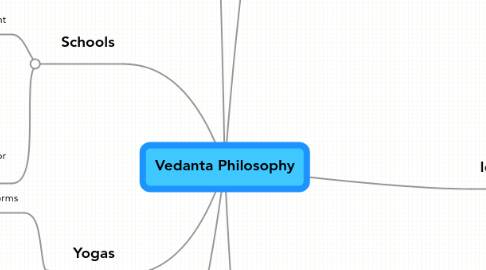
1. Schools
1.1. Schools of thought
1.1.1. Nyaya
1.1.1.1. focuses on logic
1.1.1.2. trusts slightly more in the senses
1.1.2. Mimansa
1.1.2.1. Also called 'Purva Mimansa"
1.1.3. Vaisheshika
1.1.3.1. similar to Western scientific method
1.1.3.2. theory of "atoms"
1.1.3.2.1. everything made out of pieces too small to be divided, made of earth, air, fire, or water
1.1.3.2.2. atoms "activated" by the gods
1.2. No actual buildings for distinct schools
1.2.1. buildings for debates and lectures
2. Teachers
2.1. Sri Ramakrishna
2.1.1. considered the father of modern Vedanta
2.1.2. turned Vivekananda back to Hinduism
2.1.3. taught tolerance of all religions
2.1.3.1. converted to Islam, Christianity, and Judaism for brief stints
2.2. Swami Vivekananda
2.2.1. brought vedanta to West
2.2.1.1. speaker for Hinduism at first World Conference on Religion
2.2.2. Educated in England
2.2.2.1. returned to Vedanta by Sri Ramakrishna
2.3. Yajnavalkya
2.3.1. One of the main writers of the Upanishads
2.4. Gautama Bhudda
2.4.1. considered an avatar of Vishnu
2.4.2. one of the greatest dissenters
2.4.3. founder of Bhuddism
2.4.3.1. Hindu philosophies
2.4.3.2. No Hindu gods
2.5. Adi Shankara
2.5.1. famous for consolidating many threads into Vedanta
3. Yogas
3.1. forms
3.1.1. Raja Yoga
3.1.1.1. Also known as classical yoga
3.1.2. Bhakti Yoga
3.1.3. Jhana Yoga
3.1.4. Karma Yoga
3.1.4.1. focused on action
3.1.4.2. focus on attaining good karma
3.2. A prescribed path to spiritual life
3.2.1. tools to reach higher levels of consciousness
3.2.1.1. discipline body
3.2.1.2. broaden and open mind
3.2.2. Union with supreme consciousness
4. Anne Meeker, Mr. Huston's WHI, 8th period
4.1. bibliography
5. History
5.1. Religious beginnings
5.1.1. Used religion to teach philosophy
5.2. Rise of dissension
5.2.1. dissenters argued against religion
5.2.2. gave rise to schools of thought
5.3. Golden period
5.3.1. All schools could speak and argue freely
5.3.2. Most people adored philosophers
5.3.2.1. attended staged debates
5.3.3. philosophers were funded by nobility
5.3.3.1. princes gave out cash prizes for debate winners
5.3.3.2. also taken in and supported by all classes
5.4. Fall
5.4.1. Dissension got out of hand
5.4.2. Rise of Budhhism
5.4.2.1. Much of India converted
5.4.2.2. More attention was given to Buddhist philosophers
6. Ideas
6.1. Body and Spirit
6.1.1. Spirit
6.1.1.1. Infinite consciousness
6.1.1.1.1. there for all time, goes on forever
6.1.1.2. All things are part of consciousness
6.1.1.2.1. matter is an illusion
6.1.1.3. One can "reconnect" through meditation
6.1.2. Duality
6.1.2.1. Parallels in Western philosophy
6.1.2.1.1. Descartes
6.1.2.1.2. Kant
6.1.2.1.3. Plato
6.1.2.1.4. Hume
6.1.2.2. Not true duality, since matter and spirit are not equal
6.1.3. Body
6.1.3.1. Matter is just a trick of the senses
6.1.3.2. senses need to be overcome to reach unity
6.1.3.2.1. achieved through discipline and training
6.2. Place in the world
6.2.1. senses are not enough to know
6.2.1.1. Can only be learned through higher states of consciousness
6.2.2. intellect is inadequate
6.2.2.1. not equal to greater consciousness, since only the great consciousness can perceive what it is
6.2.3. the only valuable goal is enlightenment
6.2.3.1. also known as moksha
6.3. Space, time, etc.
6.3.1. time goes through cycles of birth and death
6.3.2. all material things are part of the greater consciousness
7. Works
7.1. Vedas
7.1.1. Upanishads
7.1.1.1. choice wisdom from teachers
7.1.1.1.1. not a consistent system
7.1.1.2. main outlet for philosophical theory
7.1.2. Gitas
7.1.2.1. Bhagavad-Gita
7.1.2.1.1. elaborates on the relationship between yoga and philosophy
7.2. Religious Epics
7.2.1. Works
7.2.1.1. Mhabarat
7.2.1.2. Ramayana
7.2.1.3. Showed philosophical ideas through metaphor
